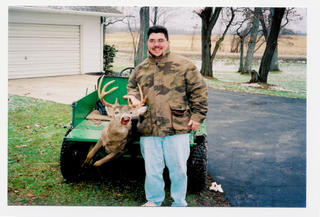2005 Whitetail Deer Rut Predictions
I have mentioned Charles Alsheimer's lunar rut predictions before. I was curious what he would predict for this year, having read his book Hunting Whitetails by the Moon and his Deer and Deer Hunting magazine articles.
In Hunting Whitetails by the Moon, Charlie calls 2005 an "oddball" year. He states, "In 2005, the pre-rut moon will occur Sept. 19, four days after the autumnal equinox. That means that in 2005, the rutting moon will occur Oct. 17." He goes on to say, "Currently, we don't have adequate data on years when this occurs, because we didn't start getting good data until 1995."
But he makes a prediction nonetheless, saying "...I believe the rutting/breeding activity associated with the pre-rut moon will follow the pattern we've seen to date." Then he adds this disclaimer, "However, there is a possibility, especially in 2005, that everything could be thrown back one month, causing the chase phase and breeding window to occur in mid- to late November and carry over into early December, similar to the way it did in 1997."
To summarize, the book predicts the chase phase of the rut will start around October 14, or possibly a month later (about November 15).
Interestingly, however, Charlie changes his prediction in the October 2005 issue of Deer and Deer Hunting magazine. In the article 2005 Lunar Rut Predictions, he predicts a mid-November rut. He states that the rut will be similar to 1997. He must have changed his mind after writing the book. The article states, "Consequently, this year's rut should be very similar to those we experienced in 1997 and 2002." I am guessing that it was the year 2002 that changed his mind. His book was written in 1999. The rut timing from year 2002 gave him more data. So he now believes that we will have a mid-November rut in 2005.
Interestingly, in 1997, Charlie wrote an article in Deer and Deer Hunting called "2002 Lunar Forecast: The Worst Rut Ever?" He predicted a "trickle" rut that would not bode well for hunters. In his 2003 lunar predictions, he stated "The bottom line to 2002 was that hunters were scratching their heads last November, trying to figure what was going on. In a nutshell the 2002 rut was far less intense than other years and as 'on again, off again,' as anyone could ever remember." He goes on to say, "The good news is that you will not see a repeat of 2002 until 2005."
So I am left to surmise his opinion to be: we will have a classic mid-November rut, though with less intensity and possibly stretched out with periods of rutting activity interspersed with periods of inactivity.
Whether he is correct or not, Charles Alsheimer is a blessing to this sport. I have the utmost respect for the man, and I encourage you to visit his website http://www.charlesalsheimer.com and buy his books. His deer photography is second to none.
In Hunting Whitetails by the Moon, Charlie calls 2005 an "oddball" year. He states, "In 2005, the pre-rut moon will occur Sept. 19, four days after the autumnal equinox. That means that in 2005, the rutting moon will occur Oct. 17." He goes on to say, "Currently, we don't have adequate data on years when this occurs, because we didn't start getting good data until 1995."
But he makes a prediction nonetheless, saying "...I believe the rutting/breeding activity associated with the pre-rut moon will follow the pattern we've seen to date." Then he adds this disclaimer, "However, there is a possibility, especially in 2005, that everything could be thrown back one month, causing the chase phase and breeding window to occur in mid- to late November and carry over into early December, similar to the way it did in 1997."
To summarize, the book predicts the chase phase of the rut will start around October 14, or possibly a month later (about November 15).
Interestingly, however, Charlie changes his prediction in the October 2005 issue of Deer and Deer Hunting magazine. In the article 2005 Lunar Rut Predictions, he predicts a mid-November rut. He states that the rut will be similar to 1997. He must have changed his mind after writing the book. The article states, "Consequently, this year's rut should be very similar to those we experienced in 1997 and 2002." I am guessing that it was the year 2002 that changed his mind. His book was written in 1999. The rut timing from year 2002 gave him more data. So he now believes that we will have a mid-November rut in 2005.
Interestingly, in 1997, Charlie wrote an article in Deer and Deer Hunting called "2002 Lunar Forecast: The Worst Rut Ever?" He predicted a "trickle" rut that would not bode well for hunters. In his 2003 lunar predictions, he stated "The bottom line to 2002 was that hunters were scratching their heads last November, trying to figure what was going on. In a nutshell the 2002 rut was far less intense than other years and as 'on again, off again,' as anyone could ever remember." He goes on to say, "The good news is that you will not see a repeat of 2002 until 2005."
So I am left to surmise his opinion to be: we will have a classic mid-November rut, though with less intensity and possibly stretched out with periods of rutting activity interspersed with periods of inactivity.
Whether he is correct or not, Charles Alsheimer is a blessing to this sport. I have the utmost respect for the man, and I encourage you to visit his website http://www.charlesalsheimer.com and buy his books. His deer photography is second to none.





